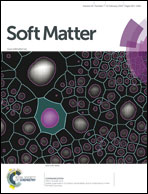Conformational changes of a single magnetic particle string within gels†
Abstract
Magnetorheological (MR) gels consist of micron sized magnetic particles inside a gel matrix. Before physical cross-linking, the suspension is subjected to a small magnetic field which creates a particle string structure. After cross-linking, the string is kept within the gel at room temperature. Under an external homogeneous magnetic field and mechanical deformation, the soft swollen gel matrix allows the string to largely rearrange at microscopic scales. With the help of two homemade magneto cells mounted on an optical microscope, we were able to follow the conformational change and instabilities of a single magnetic particle string under the combined influence of shear (or stretch) and the magnetic field. In the absence of mechanical deformation, an external magnetic field, applied in the perpendicular direction to the string, breaks it into small pieces generating periodic structures like sawteeth. When an external magnetic field is applied parallel to the pre-aligned string, it exhibits a length contraction. However, under shear strain perpendicular to the original pre-structured string (and magnetic field), the string breaks and short string segments tilt, making an angle with the original direction that is smaller than that of the applied shear (non-affine). The difference in tilt angle scales with the inverse length of the small segments L−1 and the magnetic flux density B, reflecting the ability of the gel matrix to expel solvents under local stress.


 Please wait while we load your content...
Please wait while we load your content...